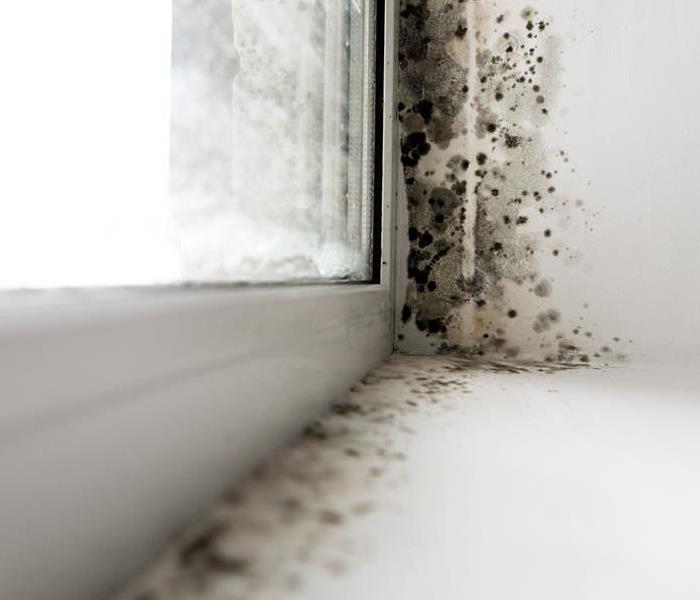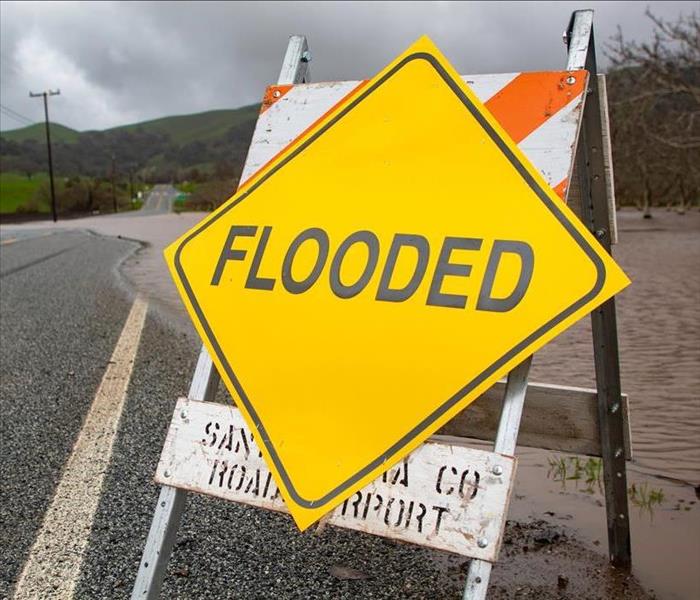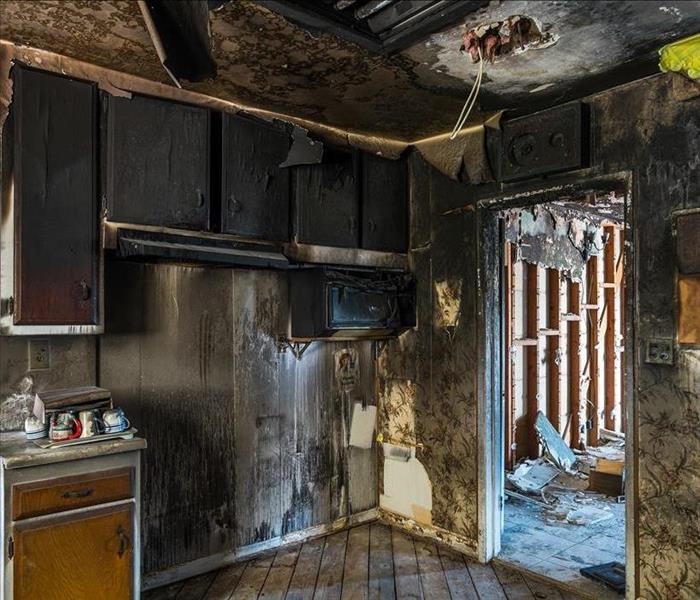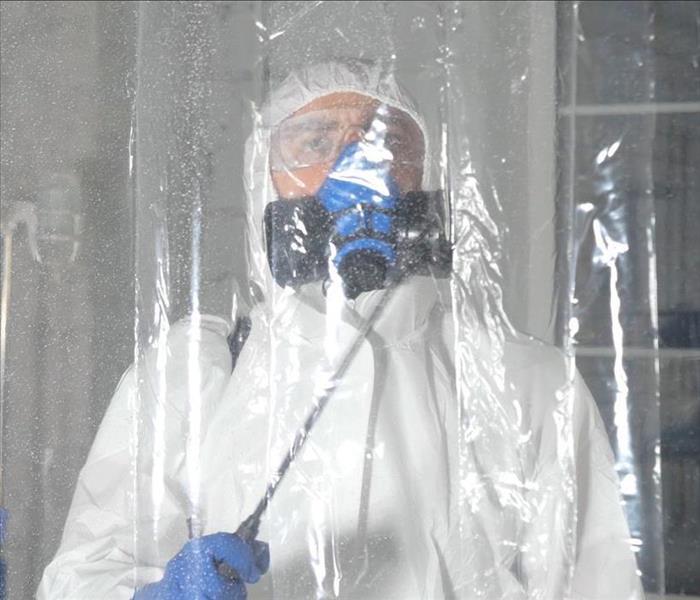Recent Posts
Mold Growth after Water Damage: How to Prevent and Treat
2/7/2024 (Permalink)
Water damage is a common occurrence in homes with the potential for mold growth as a resulting issue. In this blog post, we will discuss the causes and dangers of mold growth after water damage, and effective prevention and treatment strategies to ensure healthy living standards.
Causes of Mold Growth after Water Damage
Mold spores are present everywhere in the environment, and when combined with the availability of moisture, they can begin to grow after water damage has occurred. The sources of water damage vary from natural disasters and plumbing issues to leaky roofs and windowsills.
Dangers of Mold Growth After Water Damage
Mold growth after water damage presents significant health risks to the occupants of the affected area. Mold spores can cause respiratory issues, allergies, and in some cases, infections. Mold also makes living spaces uncomfortable and can produce unpleasant odors.
Prevention of Mold Growth After Water Damage
Prevention of mold growth after water damage requires prompt and thorough water damage mitigation. Reducing humidity levels, fixing leaks, and using dehumidifiers make an environment unfavorable for mold growth. Routine home inspections are necessary to prevent the buildup of moisture and identify early signs of mold growth.
Treatment of Mold Growth After Water Damage
Treatment of mold growth after water damage requires a multi-step process that involves identifying the extent of the damage, eliminating the moisture source, removing the affected areas, and restoring the environment to healthy living standards. Professionals recommend the use of specialized equipment, such as negative air machines and dehumidifiers, to ensure thorough mold removal.
The Role of Professional Remediation Services
Professional remediation services are necessary for mold growth cases beyond your expertise. They offer the expertise of identifying mold types, the extent of the issue, and provide an appropriate remedial approach to ensure a healthy environment. In addition, they can assist with insurance claims and advocate for the best interests of clients when dealing with water damage and mold growth.
Mold growth after water damage is a serious issue that should be tackled immediately. Effective prevention strategies can stop mold growth before it starts, while prompt treatment with the assistance of professional remediation services ensures a healthy living space for occupants. Contact our SERVPRO of Montclair/ West Orange team for professional assessment and restoration services, ensuring a better, safer home for you and your loved ones!
Winter-Ready Success: Preparing Your Business for Winter Storms
1/3/2024 (Permalink)
As winter approaches, with its chilly embrace, businesses face unique challenges posed by winter storms. From snow accumulation to freezing temperatures, proper preparation is paramount to ensure the safety of employees, maintain operational continuity, and protect assets. In this blog, we'll explore essential steps for preparing your business for the winter storms that the Northeast often experiences.
Develop a Comprehensive Winter Emergency Plan
Start by creating a winter-specific emergency plan that addresses potential challenges such as power outages, transportation disruptions, and extreme weather conditions. Clearly communicate roles and responsibilities, including emergency contacts, evacuation procedures, and communication protocols.
Conduct a Winter Facility Check
Assess your business facility for vulnerabilities to winter weather. Check for proper insulation, inspect roofs for potential leaks or ice dam formation, and ensure that heating systems are in optimal condition. Address any issues that could pose risks during winter storms.
Winterize Your Business Vehicles
If your business relies on a fleet of vehicles, make sure they are winter-ready. Equip each vehicle with winter tires, inspect brakes and fluids regularly, and provide employees with winter driving safety training. Keep a supply of ice scrapers, snow brushes, and emergency kits in each vehicle.
Maintain Heating Systems
Regularly service and maintain heating systems to ensure they function efficiently during the winter months. Schedule professional inspections to identify and address any issues that could lead to heating failures when they are needed most.
Stock Emergency Supplies
Prepare for potential power outages by stocking emergency supplies such as flashlights, batteries, blankets, and non-perishable food items. Ensure that employees know the location of emergency supplies and conduct drills to familiarize them with emergency protocols.
Monitor Weather Forecasts:
Stay vigilant by monitoring weather forecasts regularly. This allows you to anticipate potential disruptions and make informed decisions about business operations, employee safety, and possible closures or delays. With the rise of remote work, establish and test remote work options for your employees. This flexibility allows your business to continue operations even if winter storms make commuting challenging or if the physical workplace is inaccessible.
Communicate Proactively
Establish clear communication channels to keep employees informed about weather-related updates, closures, or changes to business operations. Utilize email, text messaging, and social media to ensure that critical information reaches everyone promptly. Develop a snow removal and de-icing plan for your business property. Ensure that walkways, parking lots, and entryways are promptly cleared of snow and ice to maintain a safe environment for employees and clients.
Review and Update Insurance Coverage
Regularly review your business insurance coverage to ensure it adequately protects against winter-related damages. Understand the terms of your policy, including coverage for snow-related incidents, and make adjustments as needed.
Train Employees on Winter Safety Protocols
Conduct winter safety training sessions for employees, covering topics such as safe driving in winter conditions, preventing slips and falls, and recognizing signs of cold-related illnesses. Empower employees to prioritize their safety during winter storms. Stay connected with local emergency management authorities and stay informed about community storm preparedness efforts. This collaboration can provide valuable resources and support during challenging times.
Winter storms may be inevitable, but with careful planning and proactive measures, your business can navigate the challenges they present. By prioritizing employee safety, maintaining operational resilience, and preparing for potential disruptions, you position your business for winter-ready success, ensuring that it withstands the chill and continues to thrive despite the challenges of the season.
Swift Solutions: Exploring the Benefits of 24-Hour Emergency Service for Fire Damage Restoration
11/21/2023 (Permalink)
A fire outbreak can cause significant damage to your property in a matter of minutes. The aftermath of a fire can be overwhelming and stressful, especially if your home or business has been extensively affected. This is where 24-hour emergency service for fire damage restoration comes into play. In this blog, we will highlight the significant benefits of accessing professional assistance round-the-clock during such challenging times.
Rapid Response Time
The key advantage of 24-hour emergency service is the immediate response time. Fires can occur at any hour, and the quicker the restoration process begins, the more likely it is to minimize the damage. Emergency service providers are available around the clock, ready to respond immediately to your distress calls.
Mitigating Further Damage
Fire damage can be both direct and indirect. The longer the aftermath persists, the more likely it is for secondary damage, such as water damage from firefighting efforts or mold growth, to occur. With access to 24-hour fire damage restoration services, professionals can quickly assess and implement mitigation techniques to prevent further deterioration.
Professional Expertise and Experience
Fire damage restoration is a complex process that requires specialized knowledge and techniques. Emergency service providers have extensive experience in handling fire-related disasters and are equipped with the necessary training, tools, and equipment to swiftly and effectively address fire damage. Their expertise helps ensure a thorough restoration that adheres to industry standards.
Safety and Health Considerations
Fire damage can leave behind hazardous conditions like weakened structures, air pollutants, and lingering smoke odor. 24-hour emergency service providers prioritize safety and health considerations during the restoration process. They ensure that appropriate safety measures are implemented, hazardous materials are handled properly, and the environment is thoroughly decontaminated.
Prompt Insurance Claim Assistance
Dealing with insurance companies can be a complex and time-consuming process. With 24-hour emergency service, restoration professionals can assist you in documenting and providing evidence of the fire damage swiftly. Their expertise in working with insurance claims helps streamline the process, ensuring that you receive the necessary compensation for the restoration work.
Peace of Mind and Support
Going through a fire is an emotionally draining experience. Having access to 24-hour emergency service offers crucial peace of mind, knowing that professionals are on standby to assist you during this challenging time. Their presence and support can alleviate some of the stress and anxiety associated with fire damage, allowing you to focus on rebuilding and recovery.
In conclusion, 24-hour emergency service for fire damage restoration is a valuable resource that can make a significant difference in the outcome of a fire-related disaster. The immediate response, expertise, and support provided by emergency service providers can help mitigate damage, ensure safety, and streamline the restoration process, bringing you closer to returning your home or business to its pre-fire condition.
What is the Relationship between mold and water damage?
10/24/2023 (Permalink)
 Understanding mold and water damage is crucial for home and business owners.
Understanding mold and water damage is crucial for home and business owners.
Mold and water damage often go hand in hand, creating a symbiotic relationship that can wreak havoc on homes. In this blog, we will explore the connection between mold growth and water damage, highlighting how one can lead to the other. By understanding this relationship and taking proactive measures, homeowners can effectively prevent and address mold issues resulting from water damage.
The Role of Water Damage
Water damage acts as the catalyst for mold growth. When excess moisture or water enters a home due to leaks, floods, or high humidity levels, it creates the ideal conditions for mold spores to thrive. Moisture-saturated materials such as drywall, carpeting, and insulation provide an ample food source for mold. As the water permeates these materials, it promotes the growth of mold colonies, which can rapidly spread through the affected area. Recognizing and addressing water damage promptly is essential in preventing the onset and exacerbation of mold growth.
Warning Signs of Water Damage
Being able to identify the signs of water damage is essential for early detection and prevention of mold growth. Common indicators include water stains or discoloration on walls, ceilings, or floors. Peeling or bubbling paint or wallpaper can also signal water damage. Musty odors, dampness, or an increase in humidity within a particular area may suggest underlying water issues. Additionally, warped or buckling flooring, visible mold or mildew growth, or persistent plumbing leaks should be addressed promptly to mitigate the risk of mold development.
Preventing Mold Growth after Water Damage
After experiencing water damage, it is crucial to take immediate action to prevent mold growth. The first step is to identify and address the source of water intrusion, whether it's a leaky pipe, roof, or a plumbing issue. Swiftly drying out affected areas is crucial in inhibiting mold growth. Utilizing dehumidifiers, fans, and opening windows can aid in the drying process. Thoroughly cleaning and disinfecting surfaces with appropriate solutions is also necessary to prevent mold spores from taking hold. Proper ventilation and insulation can further help in reducing moisture and promoting air circulation to prevent future water-related issues.
Mitigating Mold Growth after Severe Water Damage
In cases of severe water damage, such as floods or extensive plumbing leaks, mold growth can be difficult to prevent without professional help. When dealing with significant water damage, it is prudent to engage the services of qualified mold remediation professionals. They can assess the extent of water damage and mold growth and implement appropriate remediation measures. This may include removing affected building materials, such as drywall or flooring, and thoroughly drying out the area to prevent the growth of mold spores. Additionally, utilizing specialized equipment and techniques, such as air scrubbers and negative air pressure units, can further aid in preventing mold spores from spreading to other areas of the home.
Understanding the symbiotic relationship between mold and water damage is vital for homeowners to effectively manage these issues. By promptly addressing and repairing water damage, implementing preventive measures, and ensuring proper drying and cleaning protocols, homeowners can prevent or minimize the risks of mold growth in their homes. Vigilance and timely action can safeguard homes from the damaging effects of mold resulting from water damage.
Rebuilding Together: The Power of Community After Water-Related Disasters
10/21/2023 (Permalink)
 In times of crisis, the power of community resources and support is immeasurable.
In times of crisis, the power of community resources and support is immeasurable.
Water-related disasters, such as floods or severe storms, can leave communities devastated. The aftermath of such events can be overwhelming, both physically and emotionally. However, during these challenging times, communities often come together to provide support and resources to those affected. In this blog post, we will explore the importance of community resources and support after water-related disasters and highlight some key ways in which affected individuals can seek help.
Emergency Shelters
During and immediately after a water-related disaster, emergency shelters are often set up to provide temporary housing for those displaced from their homes. These shelters offer a safe and secure place to stay, with basic amenities, such as food, water, and medical assistance.
Various local and national disaster relief organizations step in to provide assistance after water-related disasters. These organizations offer resources such as food, clean water, clothing, and financial aid to those affected. They also provide counseling services and access to mental health professionals to help individuals cope with emotional trauma.
Volunteer Groups
Community members often form volunteer groups to help with cleanup and recovery efforts. These groups lend a hand in clearing debris, mucking out flooded homes, and assisting with repairs and rebuilding. Their efforts play a crucial role in supporting affected individuals and helping them restore their lives.
Donations and Fundraisers
Many individuals, businesses, and organizations rally together to organize donation drives and fundraisers. These initiatives collect essential items, such as clothing, bedding, toiletries, and household supplies, to distribute among those in need. Fundraisers help raise funds for long-term recovery and rebuilding efforts.
Local Government Assistance
Local governments typically mobilize resources to provide assistance to the community after water-related disasters. They may establish hotlines and information centers to help residents access necessary services. Governments also offer support programs, grants, or low-interest loans to aid in home repairs and recovery.
Insurance Claims and Legal Assistance
Dealing with insurance claims after a disaster can be complex and overwhelming. Community resources may include guidance on filing claims, connecting with insurance professionals or legal experts who can provide the necessary support, and ensuring individuals receive the coverage they are entitled to.
Education and Preparedness Programs
Communities often offer educational resources and preparedness programs to help residents better understand and prepare for future water-related disasters. These initiatives provide information on emergency preparedness kits, evacuation plans, and steps to safeguard homes and properties from future damage.
In times of crisis, the power of community resources and support is immeasurable. Coming together as a community not only helps in the immediate recovery but also instills a sense of hope, resilience, and unity. By accessing these resources and leaning on the support of others, individuals and communities can navigate the challenges of water-related disasters and rebuild their lives with strength and determination.
Severe Weather Outages: Ensuring Safety and Comfort During Storms
9/18/2023 (Permalink)
 Keep yourself updated about weather forecasts and storm alerts.
Keep yourself updated about weather forecasts and storm alerts.
As a homeowner or property owner, preparing for severe weather outages is crucial to safeguarding your family's safety and ensuring maximum comfort during storms. Severe weather events, such as hurricanes, blizzards, or thunderstorms, can lead to power outages, making it essential to have a well-thought-out plan in place. In this article, we'll explore practical steps you can take to ensure safety and comfort during these challenging times.
Develop an Emergency Plan
Creating a comprehensive emergency plan is the first step in preparing for severe weather outages. Involve all members of your household in the planning process and discuss roles and responsibilities during emergencies. Your plan should include:
Identifying safe areas: Designate shelter spaces within your home that offer protection from severe weather, such as basements or interior rooms away from windows.
Emergency contact list: Prepare a list of emergency contacts, including local authorities, utility companies, and family members. Keep this list accessible to everyone.
Evacuation routes: Familiarize yourself with evacuation routes in your area and establish a meeting point outside your home where everyone can gather in case of evacuation.
Essential supplies: Stock up on emergency supplies like non-perishable food, water, first-aid kits, flashlights, batteries, and necessary medications.
Backup Power Solutions
Investing in a backup power solution is a smart decision to maintain some level of comfort during power outages. Consider the following options:
Generators: Portable or standby generators can provide electricity during extended outages. However, make sure to follow safety guidelines and use them outdoors to avoid carbon monoxide poisoning.
Solar-powered chargers: Utilize solar-powered chargers to keep essential devices like smartphones and flashlights powered up during prolonged power cuts.
Secure Your Property
Protecting your home or property from severe weather damage can minimize the impact of storms. Here are some measures to consider:
Roof and gutter maintenance: Regularly inspect and maintain your roof and gutters to ensure they are in good condition. Properly installed and maintained gutters can prevent water damage during heavy rain.
Trim trees and branches: Prune trees near your property to minimize the risk of falling branches during storms. Overhanging limbs can cause significant damage to your home and power lines.
Reinforce windows and doors: Install storm shutters or board up windows and doors to protect against flying debris and high winds.
Stay Informed
Keep yourself updated about weather forecasts and storm alerts. Use weather apps or tune into local news channels for real-time information. Staying informed will give you ample time to activate your emergency plan if severe weather is approaching.
Collaborate with Neighbors
Creating a sense of community and collaboration with your neighbors can be immensely helpful during severe weather outages. Look out for each other and offer assistance when needed. Sharing resources and information can make the recovery process smoother for everyone.
Severe weather outages can be challenging, but with proper preparation and planning, you can ensure the safety and comfort of your family and property during storms. Develop a detailed emergency plan, invest in backup power solutions, secure your property, stay informed, and collaborate with neighbors. By taking these proactive measures, you can confidently weather any storm that comes your way. Stay safe and be prepared!
Rebuilding After a Fire: What Sets SERVPRO Apart?
8/14/2023 (Permalink)
 Choosing the right company for rebuilding after a fire is a critical decision that can greatly impact the outcome of your property's restoration.
Choosing the right company for rebuilding after a fire is a critical decision that can greatly impact the outcome of your property's restoration.
Recovering from a fire can be an overwhelming and challenging experience for homeowners. After the flames are extinguished, the process of rebuilding and restoring your property begins. Choosing the right company for post-fire rebuild services is crucial to ensure a smooth and successful restoration. In this article, we will explore what sets SERVPRO apart as a leading choice for rebuilding after a fire. Understanding their unique qualities and expertise can help homeowners make an informed decision during this critical phase of recovery.
Prompt Response and Emergency Services
In the aftermath of a fire, time is of the essence. SERVPRO is known for its rapid response and 24/7 emergency services. Their dedicated teams of professionals understand the urgency and importance of starting the restoration process quickly. By promptly assessing the damage and initiating the necessary steps, they can mitigate further damage and expedite the recovery timeline.
Comprehensive Assessment and Planning
SERVPRO takes a meticulous approach to assessing the extent of fire damage and creating a tailored restoration plan. Their experienced professionals conduct a thorough inspection of the property, identifying not only visible damage but also hidden issues such as smoke residue, soot infiltration, and structural concerns. This comprehensive assessment ensures that no damage goes unnoticed, allowing for a more comprehensive restoration strategy.
Integrated Restoration Services
What sets SERVPRO apart is their ability to provide a wide range of integrated restoration services. They are equipped to handle all aspects of the rebuilding process, from cleanup and debris removal to structural repairs and reconstruction. By offering a comprehensive solution under one roof, SERVPRO eliminates the need for homeowners to coordinate multiple contractors, simplifying the process and minimizing delays.
Industry Expertise and Experience
With decades of experience in the restoration industry, SERVPRO has developed a deep understanding of fire damage and the complexities involved in the rebuilding process. Their teams consist of trained and certified professionals who possess the necessary expertise to handle various types of fire damage scenarios. This knowledge, combined with their access to advanced equipment and techniques, enables them to deliver efficient and high-quality restoration services.
Insurance Coordination and Documentation
Navigating the insurance claim process can be overwhelming for homeowners dealing with the aftermath of a fire. SERVPRO's expertise extends beyond restoration and includes insurance coordination. They work closely with insurance companies, providing detailed documentation and necessary information to facilitate a smoother claims process. This support helps homeowners maximize their insurance coverage and alleviate the burden of handling the paperwork independently.
Commitment to Customer Satisfaction
SERVPRO prioritizes customer satisfaction throughout the rebuilding process. Their teams strive to deliver exceptional service, communicating transparently with homeowners, and keeping them informed at every stage. By maintaining open lines of communication, addressing concerns promptly, and ensuring the highest level of professionalism, SERVPRO aims to provide peace of mind to homeowners during a challenging time.
Choosing the right company for rebuilding after a fire is a critical decision that can greatly impact the outcome of your property's restoration. SERVPRO's prompt response, comprehensive assessment, integrated services, industry expertise, insurance coordination, and commitment to customer satisfaction set them apart as a leading choice for post-fire rebuild services. By entrusting your property's restoration to SERVPRO, homeowners can have confidence in a dedicated team of professionals who will work tirelessly to rebuild and restore their home, helping them move forward with confidence and a renewed sense of security.
How to Prepare for an Insurance Adjuster's Visit After a Water Leak
7/18/2023 (Permalink)
Dealing with a water leak in your home can be a stressful experience. From the initial damage to the cleanup and restoration process, there are many steps involved in getting your property back to normal. One crucial step in this process is the visit from the insurance adjuster. Their role is to assess the damage and determine the coverage and compensation you're entitled to. To ensure a smooth and successful insurance claim, it's important to be prepared for the adjuster's visit. In this blog post, we'll provide you with essential tips on how to effectively prepare for the insurance adjuster's visit after a water leak.
Document the Damage
Before the adjuster arrives, document the water damage thoroughly. Take clear and detailed photos or videos of all affected areas, including damaged belongings, structural issues, and any visible signs of water intrusion. This evidence will serve as valuable documentation for your insurance claim.
Create an Inventory of Damaged Items
Make a detailed inventory of all damaged items caused by the water leak. Include information such as descriptions, quantities, ages, and estimated values. Having a comprehensive list will facilitate the claims process and ensure you receive appropriate compensation for your losses.
Gather Relevant Documentation
Collect all relevant documents related to your property and insurance policy. This includes your homeowner's insurance policy, previous claims, maintenance records, and any receipts or invoices for repairs or improvements. Having these documents readily available will assist the adjuster in assessing your claim accurately.
Be Present During the Inspection
When the adjuster arrives, make sure to be present during the inspection. Accompany them as they assess the damage and ask any questions you may have. Take notes and keep a record of the conversation for reference. By being present, you can provide additional information and ensure a thorough evaluation of the damage.
Provide a Detailed Account of the Incident
Be prepared to provide a detailed account of the water leak incident. Explain when and how the leak occurred, the steps you took to mitigate the damage, and any repairs or restoration work already completed. The adjuster will rely on this information to understand the cause and extent of the water damage.
Ask Questions and Seek Clarification
Don't hesitate to ask questions or seek clarification during the adjuster's visit. If there are aspects of the process or coverage that you don't understand, ask for clarification. Understanding the scope of your policy and the claim process will help you make informed decisions and ensure a fair settlement.
Maintain Detailed Records
Throughout the insurance claim process, maintain detailed records of all interactions, including phone calls, emails, and written correspondence. Note down the names, titles, and contact information of anyone you speak with regarding your claim. These records will be valuable if any issues arise or if further clarification is needed in the future.
Preparing for an insurance adjuster's visit after a water leak is crucial to ensure a smooth and successful claims process. By documenting the damage, creating an inventory, gathering relevant documents, being present during the inspection, providing a detailed account of the incident, asking questions, and maintaining detailed records, you'll be well-prepared to navigate the insurance claim process effectively. Remember, professional assistance from a reputable water damage restoration company can also help streamline the process and ensure your rights are protected.
At SERVPRO of Montclair/West Orange, we understand the complexities of dealing with water damage and insurance claims. Our team of experts is ready to assist you in the restoration process and provide guidance throughout the claims process. Contact us today to learn more about our comprehensive water damage restoration services and how we can support you during this challenging time.
Exploring Flood Damage Coverage: Does Homeowners Insurance Protect You?
7/10/2023 (Permalink)
 Make sure you have the appropriate flood insurance coverage to protect your property.
Make sure you have the appropriate flood insurance coverage to protect your property.
As a homeowner, protecting your property from unexpected disasters is a top priority. Among the potential threats, flooding can cause significant damage and financial strain. Many homeowners wonder whether their standard homeowners insurance policy covers flood damage. In this blog post, we will delve into the topic of flood damage coverage, helping you understand the extent of protection offered by homeowners insurance and the importance of additional flood insurance to safeguard your home and belongings.
Standard Homeowners Insurance and Flood Damage
It's crucial to note that standard homeowners insurance policies typically do not cover damage caused by floods. These policies are designed to protect against specific risks, such as fire, windstorms, or theft. Flood damage is considered a separate peril that requires specialized coverage due to its unique nature and potential for widespread devastation. Understanding the limitations of your standard policy will help you make informed decisions regarding flood protection.
Defining Flood Damage
To better understand flood insurance, it is important to define what constitutes a flood. In insurance terms, a flood is defined as an excess of water that covers normally dry land. This can result from heavy rainstorms, overflowing rivers or lakes, tidal surges, or rapid snowmelt. Even a few inches of water can cause significant damage to your home's structure, foundation, electrical systems, and personal belongings.
The Benefits of Flood Insurance
Securing flood insurance offers several key benefits for homeowners. First and foremost, it provides financial protection in the event of a flood, covering the costs associated with repairing or rebuilding your home and replacing damaged belongings. Flood insurance can help you recover more quickly and minimize the financial burden often associated with flood-related losses.
Assessing Your Flood Risk
Evaluating your flood risk is a crucial step in determining the necessity of flood insurance. FEMA provides Flood Insurance Rate Maps (FIRMs) that identify areas at different levels of flood risk. These maps can help you understand the likelihood of flooding in your area and assess the need for adequate coverage. Keep in mind that even properties outside high-risk zones can still experience flooding, making flood insurance a valuable investment for most homeowners.
While standard homeowners insurance policies typically do not cover flood damage, it's essential to recognize the importance of obtaining flood insurance to protect your home and belongings. Floods can happen anywhere, and the costs associated with repairs and recovery can be significant. By understanding the limitations of your existing policy and assessing your flood risk, you can make informed decisions about securing appropriate flood insurance coverage.
The Importance of Containment During Mold Remediation
5/16/2023 (Permalink)
 Containment is a crucial step in the mold remediation process.
Containment is a crucial step in the mold remediation process.
Mold remediation is the process of removing mold from a building or home. One of the most important steps in the remediation process is containment. Containment refers to the use of physical barriers to prevent the spread of mold spores to other areas of the building. In this blog, we will explore why containment is so important during mold remediation and provide some tips on how to properly contain mold.
Understanding Mold Containment
Mold containment is the process of creating a physical barrier around the area where mold is present. This barrier is designed to prevent the spread of mold spores to other areas of the building. Containment can be achieved through a variety of methods, including the use of plastic sheeting, negative air pressure machines, and HEPA filters.
Preventing Cross-Contamination
The main reason why containment is so important during mold remediation is to prevent cross-contamination. Mold spores can easily spread to other areas of the building if they are not contained properly. This can lead to new areas of mold growth and make the remediation process much more difficult.
Protecting the Health of Occupants
Another important reason for containment during mold remediation is to protect the health of the building occupants. Mold can cause a variety of health problems, including allergies and respiratory issues. By containing the mold, the risk of exposure to mold spores is reduced, which can help to protect the health of the building occupants.
Preventing Damage to Building Materials
Mold can cause serious damage to building materials if left untreated. This can include damage to walls, ceilings, floors, and even furniture. By containing the mold and removing it promptly, the risk of damage to building materials is greatly reduced. This can save building owners a significant amount of money in repairs and replacements.
Tips for Proper Mold Containment
Proper containment during mold remediation is critical for a successful outcome. Here are some tips for properly containing mold:
- Use plastic sheeting to create a physical barrier around the affected area.
- Use negative air pressure machines to create a vacuum effect that pulls air into the containment area, preventing mold spores from escaping.
- Use HEPA filters to trap mold spores and prevent them from entering the air outside of the containment area.
- Wear proper personal protective equipment (PPE), including gloves, respirators, and disposable coveralls, to prevent the spread of mold spores to other areas of the building.
In conclusion, containment is a crucial step in the mold remediation process. It helps to prevent the spread of mold spores to other areas of the building, protect the health of building occupants, prevent damage to building materials, and ultimately ensure a successful outcome. By properly containing mold during the remediation process, building owners can prevent further mold growth and protect the health of everyone in the building.






 24/7 Emergency Service
24/7 Emergency Service





